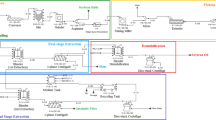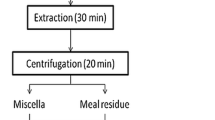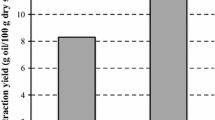Abstract
Oil can be removed from oilseed materials by a process which consists of an aqueous extraction of the comminuted seed, followed by a centrifugal separation which divides the aqueous extract into oil, solid, and aqueous phases. The protein may be recovered in the solids or aqueous phase, depending upon the conditions selected. Unit operations of this process are grinding, solid-liquid separation, centrifugation, demulsification, and drying of products. Aqueous extraction has been applied, to date, to coconuts and peanuts. For coconuts, a procedure has been developed to recover 93% of the oil and 91% of the protein. The major protein product is 25% protein and, when reconstituted in water, forms an acceptable beverage. The estimated production cost of this product is $.24/1b. For peanuts, the recovery of oil was 89% and protein 92% for the concentrate procedure, whereas the corresponding values for the isolate procedure were 86% and 89%, respectively. The costs of production were estimated as $.17/1b of concentrate (67% protein) and $.28/1b of isolate (89% protein). Aqueous extraction offers several advantages over conventional solvent extraction-less initial capital investments, safer operation, capability of discontinuous operation, and production of a variety of products. Another advantage of aqueous processing is the capability for utilization of certain chemicals to remove or inactivate undesirable substances. In the case of peanuts, hydrogen peroxide and sodium hypoehlorite have proven to be effective for destruetion of aflatoxins. Aqueous processing has the potential for application to a variety of other oilseeds.
Similar content being viewed by others
References
Chayen, I.H., and D.R. Ashworth, J. Appl. Chem. 3:529 (1953).
Sugarman, N., U.S. Pat. 2,762,820 (1956).
Dangoumau, A., Rev. Franc. Corps Gras 5:254 (1958).
Subrahmanyan, J., D.S. Bhatia, S.S. Kalbag, and N. Subramanian, JAOCS 36:66 (1959).
Chayen, I.H., U.S. Pat. 2,928,821 (1960).
Rajasekharan, N., “Chemical and Technological Investigations on Coconut Products,” Thesis, Banaras Hindu University, Utter Pradash, India, 1964.
Bhatia, D.S., M.A.B. Parpia, and B.P. Baliga, J. Food Sci. Technol. (India) 3:2 (1966).
Eapan, K.E., S.S. Kalbag, and V. Subrahmanyan, J. Amer. Chem. Soc. 43:585 (1966).
Rajasekharan, N., and A. Sreenivasan, J. Food Sci. Technol. (India) 4:59 (1967).
Sreenivasan, A., “Nutrition Document,” R9/Add 5 PAG, WHO-FAO-UNICEF, Geneva, 1963.
Smith, R.H., Adv. Chem. Series 57:133 (1966).
Orr, E., and D. Adair, “Tropical Products Institute Report,” G-31, Ministry of Overseas Development, Great Britain, June 1967.
Hagenmaier, R.D., C.M. Cater, and K.F. Mattil, J. Food Sci. 38:516 (1973).
Rhee, K.C., C.M. Cater, and K.F. Mattil, Ibid. 37:90 (1972).
Rhee, K.C., C.M. Cater, and K.F. Mattil, Ibid. 38:126 (1973).
Watt, B.K. and A.L. Merrill, “Agricultural Handbook,” No. 8, Agricultural Research Service, U.S. Department of Agriculture, 1963.
U.S. Department of Agriculture, “Agricultural Statistics,” U.S. Department of Agriculture, 1972.
Rhee, K.C., K.R. Natarajan, C.M. Cater, and K.F. Mattil, J. Amer. Peanut Res. Education Assoc. 4:215 (1972).
Sreenivasamurthy, V., H.A.B. Parpia, S. Srikanta, and A.S. Murti, J. Assoc. Offic. Agr. chemists 50:350 (1967).
Fischbach, H., and A.D. Campbell, Ibid. 48:28 (1965).
Sosulski, F.W., and C.W. McCleary, J. Food Sci. 37:253 (1972).
Sosulski, F.W., F.S. Soliman, and R.S. Bhatty, Can. Inst. Food Technol. J 5:101 (1972).
Author information
Authors and Affiliations
About this article
Cite this article
Cater, C.M., Rhee, K.C., Hagenmaier, R.D. et al. Aqueous extraction—An alternative oilseed milling process. J Am Oil Chem Soc 51, 137–141 (1974). https://doi.org/10.1007/BF02639723
Received:
Issue Date:
DOI: https://doi.org/10.1007/BF02639723




